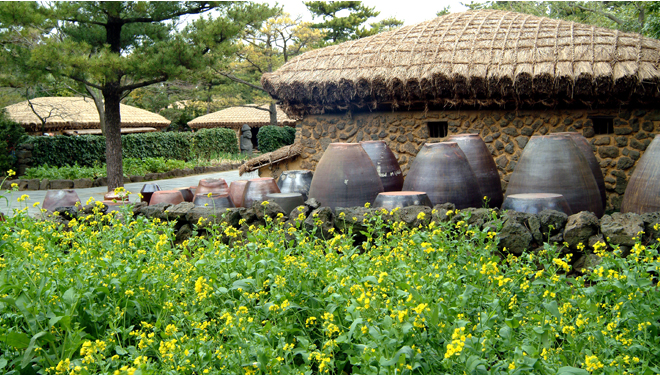Public enterprise working for the happiness of all through tourism, JTO
Jeju
HOME > Jeju > Food, Lodging and Clothing
Food, Lodging and Clothing
-

-
Jeju Island has a unique culture of food, clothing, and housing due to the geographic characteristics of the island and its unusual natural environment. Even today, citizens of Jeju Island maintain this unique, traditional flavor reflecting the island’s nature in their houses, tools, and clothing.
- Clothes Food House
- House
-

- Jeongnang and Olle
- Jeju’s traditional houses are surrounded by olle, which is a type of stone outer wall or fence, unique to the island. ‘Gates known as jeongnang’ are placed at the entrance of each olle. A jeongnang consists of is three logs placed across the entrance of the olles and held at each side by jeongjumok, or stone pillars. Jeongnang are regarded to have been originally to keep horses and cows, which the people of Jeju traditionally raised from coming into the house compound. Because of the strong winds on the island, logs were used instead of gates. Jeongnang are not affected by the wind so would not be broken even during typhoons. The three logs were also a means of exchanging information between the owner of the house and potential guests. If all three logs were in place, it meant nobody was home. If two logs were in use, the owner was going to be out for a long time, but when only one log was used, the owner was expected back shortly. The length of each house’s olle varied and they could be short or long. There were also many different type of olle and they could be straight or curved, and wider or narrower at the end. Traditional homes always had olle though. As Jeju’s frequent and strong winds were gentled when they passed through the piled stone walls. The houses were not easily seen from the street due to the olle and their role was to both prevent strong winds and curious eyes from reaching the house. Jeongnang and olle are found only in Jeju and are a residential view unique not only in Korea, but throughout the world.
-
- Choga (Thatched roof house)
- Jeju’s choga (thatched roof houses) are a unique type found only on the island. They are strong with piled stone walls made even stronger by covering them with soil. The roofs are covered with straw that is held down by thick ropes tied tightly in a checkerboard pattern. The early residents of Jeju tried to overcome the abundant rain and wind of their natural environment and in their wisdom, devised the unique thatched roof houses of Jeju. All houses in Jeju are shaped like the Chinese character for one (ㅡ), which is a horizontal line and lack the front yard and detached house common to houses in other regions of Korea. In the traditional thatched roof houses of Jeju, there is an angeori (main building) and a bakgeori (subordinate building). The angeori is the place where food is stored and memorial rituals are performed. The parents of a family lived in the angeori, and after their eldest son was married, he and his family would live in the bakgeori. After a certain period, they would change places with each other, indicating that the duty of performing the memorial rituals had moved from the parents’ generation to the son’s. All affairs regarding relatives, collaborative labor, common property, and participation in meetings were managed by the people living in the angeori. The angeori has a much more significant function. Each angeori and bakgeori had a separate kitchen, jangdokdae (jar stand), and tongsi (toilet) so that each generation could live independent lives. These houses were single-family residential units; however they were double-family economic units. The traditional houses of Jeju illustrate complex aspects of Jeju society such as coping with the island’s climate, a theory of divination based on topography and shamanism, and the unique family structure of Jeju Island.
-
- Dottongsi (Pig-Latrine)
- The Dottongsi is Jeju’s traditional outhouse. It had low walls to repel the wind and prevent outside eyes from peeking in, but had no roof. It did not smell and users didn’t need to worry about getting spattered excrement on the bottom of their feet or falling into it. It was a clean toilet where users could do their business safely while looking around at the view. Dottongsi were not only toilets but pigsties as well. The bottom of the dottongsi was spread with barley straw and pigs were raised there eating human excrement and food scraps. The barley straw mixed with the pig excrement fermented naturally and the manure produced was important to Jeju’s agricultural industry. Dottongsi are a unique aspect of residential life found only in Jeju that not only kept the natural environment clean by recycling seemingly useless waste, but also produced natural manure which was used in farming.




